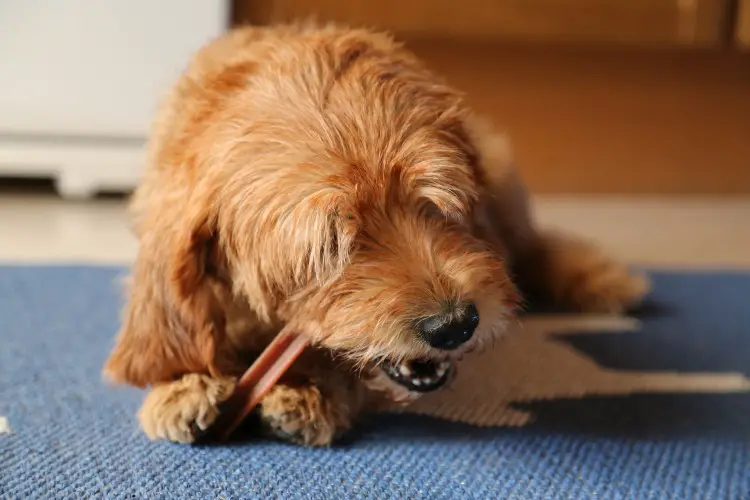Like all living things, dogs need food to live. Calories fuel a dog’s exercise, macronutrients support their metabolisms, and protein and fat help manage tissue growth. Therefore, having an appetite is a good indication of a healthy dog, while appetite loss is a sign that something might be wrong.
A dog may stop eating for several reasons. Luckily, he can survive without food for quite a while. How long that depends on a number of factors.
How Long Can a Dog Live Without Food?
A healthy dog can survive around 3-5 days without food, assuming they are still drinking water or have access to it. Elderly, sickly, pregnant, or nursing dogs and young puppies may survive up to three days. Without food and water, a dog may survive only a handful of days, eventually dying of dehydration before starvation symptoms show.
Why Do Dogs Stop Eating?
Dogs can’t exactly tell their owners when something is wrong, so it’s up to the owner to figure out the reason their dog may have stopped eating. Loss of appetite can happen because of something as grave as a chronic illness or as benign as a dog’s general pickiness, with a million reasons in between of varying degrees of seriousness. In spite of this variety, the reason for a dog’s loss of appetite generally falls in one of three categories:
- Medical
- Mental
- Environmental
Medical Reasons
When a dog stops eating, the first thing the owner should suspect is an illness. Gastrointestinal issues, pain, and intestinal parasites are just three of many common medical issues that can cause a dog to lose his appetite. Sometimes, a dog may need a day for its stomach to settle before its appetite returns to normal. In serious cases, appetite loss is accompanied by other serious symptoms.
Examples of Medical Issues
- Upset Stomach
- Allergies
- Arthritis
- Dental disease
- Intestinal blockage
- Parasites
Mental Reasons
Sometimes, people stop eating if they’re feeling depressed or anxious. In the same way, dogs can also lose their appetite due to an underlying mental cause. Anxiety, such as separation anxiety, can cause dogs to become destructive and act out-of-character, including brief periods of appetite loss. Depression can occur in dogs when there are huge changes in the home, such as the presence of a new baby or the loss of a fellow pet companion.
Signs of Depression and Anxiety
- Panting
- Changes in sleeping or eating habits
- Hiding from owner
- Listlessness
- Loss of appetite
Environmental Reasons
Environmental stimuli can result in changes in a dog’s eating habits, including the loss of his appetite. Generally, these environmental causes can come directly from the food itself, like spoiled or bad food, or the dog’s immediate surroundings, like a brand new house. If you suspect an environmental cause for your dog’s appetite loss, examine his food for signs of spoilage, or try to identify if there is something in his environment making him uncomfortable.

When to Call a Vet
You should contact a veterinarian if your dog has refused food for more than a day, or if the appetite loss is accompanied by vomiting or diarrhea. If you know for sure that your dog has eaten something toxic (or spoiled meat), feel a blockage in their abdomen, or notice signs of parasitic infection, you should also contact your vet even if your dog has just started refusing food.
How to Get Your Dog to Eat
If you’ve already spoken to a vet, double-checked your dog’s food, and made his environment as comfortable as possible, here are some tempting hacks to help your dog love food again. These tips are also helpful if you have a particularly picky but otherwise healthy dog. We’ve previously written about how much a puppy should eat.
Offer Kibble with Mix-Ins
Next mealtime, try presenting your dog’s usual bowl of kibble with a dog-friendly mix-in or dressing, like broth, chunks of real meat, or a scoop of canned dog food. Some pet stores also carry seasonings that are meant for dressing up a boring serving of kibble. Remember to mix everything together, otherwise, your dog might just eat the good stuff on top and leave everything else in the bowl.
Heat Up the Food
Warming up dog food can enhance its smell and flavor, helping your dog get more excited about dinnertime. Make sure to use microwave-safe bowls and that the food isn’t hot enough to burn your dog’s mouth. For kibble-only diets, you can introduce a little heat by pouring some warm broth or water over the food.
Avoid Too Many Treats and Table Scraps
Too many treats can spoil a dog’s appetite. It can also teach him that if he doesn’t eat his food, he might get a treat later. The same goes for table scraps. Ideally, treats should account for up to 10% of a dog’s diet.
Start Exercising More
Exercise not only burns calories, but it also supports digestion, both of which help your dog feel hungry. A walk around the block is the perfect way to get a dog’s appetite up before dinner. If your dog is already active, then a game of tug-of-war or fetch, a longer walk, or even a run are all great ways to challenge an active dog.
All Dogs Love to Eat
…Have you ever met one that doesn’t? That’s why it’s so serious if a dog has stopped eating. Chances are, he’ll get back to normal within a day. If he doesn’t, an experienced veterinarian can help you find the root of the cause.
